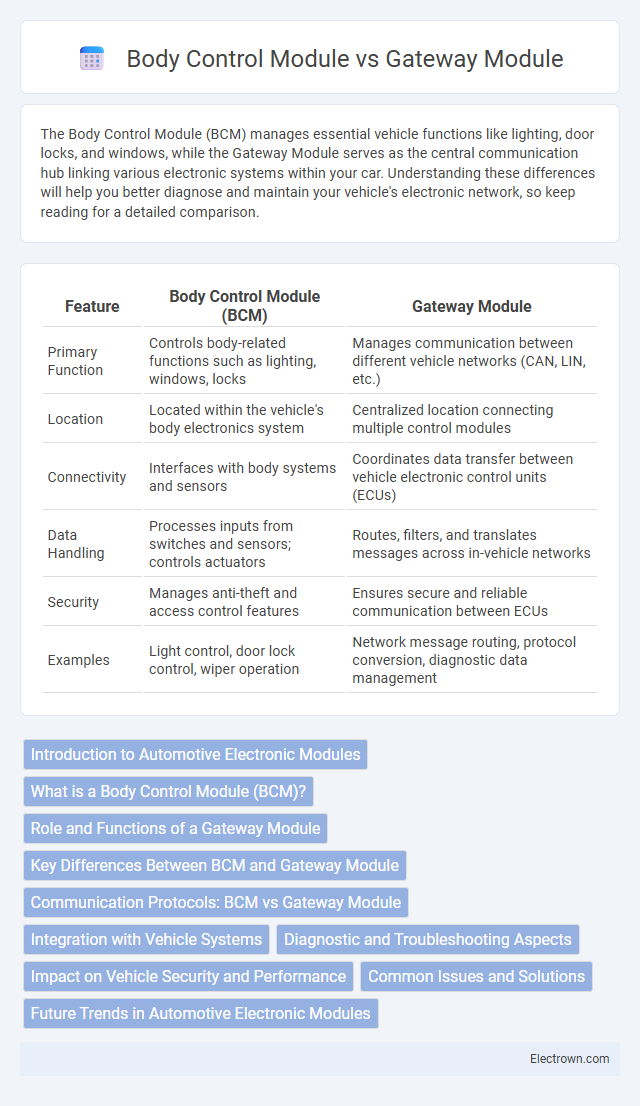The Body Control Module (BCM) manages essential vehicle functions like lighting, door locks, and windows, while the Gateway Module serves as the central communication hub linking various electronic systems within your car. Understanding these differences will help you better diagnose and maintain your vehicle's electronic network, so keep reading for a detailed comparison.
Table of Comparison
| Feature | Body Control Module (BCM) | Gateway Module |
|---|---|---|
| Primary Function | Controls body-related functions such as lighting, windows, locks | Manages communication between different vehicle networks (CAN, LIN, etc.) |
| Location | Located within the vehicle's body electronics system | Centralized location connecting multiple control modules |
| Connectivity | Interfaces with body systems and sensors | Coordinates data transfer between vehicle electronic control units (ECUs) |
| Data Handling | Processes inputs from switches and sensors; controls actuators | Routes, filters, and translates messages across in-vehicle networks |
| Security | Manages anti-theft and access control features | Ensures secure and reliable communication between ECUs |
| Examples | Light control, door lock control, wiper operation | Network message routing, protocol conversion, diagnostic data management |
Introduction to Automotive Electronic Modules
Automotive electronic modules such as the Body Control Module (BCM) and Gateway Module play crucial roles in vehicle communication and control systems. The BCM manages key body-related functions including lighting, door locks, and windows, while the Gateway Module facilitates data exchange between different vehicle networks, ensuring seamless communication across various electronic control units. Understanding these modules helps you optimize vehicle diagnostics and improve overall electronic system integration.
What is a Body Control Module (BCM)?
A Body Control Module (BCM) is an electronic control unit in vehicles responsible for managing various body-related functions such as lighting, power windows, door locks, and climate control systems. It processes input from sensors and switches to control electrical components, enhancing vehicle safety and convenience. Your vehicle's BCM communicates with other modules, including the Gateway Module, to ensure seamless operation of integrated systems.
Role and Functions of a Gateway Module
The Gateway Module serves as a central communication hub within a vehicle, managing data flow between various electronic control units (ECUs) such as the Body Control Module and powertrain systems. It ensures seamless integration and coordination of signals, enhancing network security and data filtering to prevent unauthorized access. Your vehicle relies on the Gateway Module to maintain efficient communication across different network protocols, optimizing system performance and reliability.
Key Differences Between BCM and Gateway Module
The Body Control Module (BCM) primarily manages vehicle functions such as lighting, windows, and door locks, while the Gateway Module acts as a communication hub, connecting various networks within the vehicle for data exchange. BCM directly controls physical components and ensures seamless operation of body-related systems, whereas the Gateway Module facilitates communication between electronic control units (ECUs) across different protocols. Understanding the key differences helps optimize Your vehicle's diagnostics and electronic system integration.
Communication Protocols: BCM vs Gateway Module
The Body Control Module (BCM) primarily uses Controller Area Network (CAN) and Local Interconnect Network (LIN) protocols to manage vehicle subsystems such as lighting, windows, and security. The Gateway Module acts as a central communication hub, translating and routing data between different networks like CAN, LIN, FlexRay, and Ethernet to ensure seamless connectivity across various electronic control units. Understanding these communication protocols helps optimize your vehicle's electronic system performance and integration.
Integration with Vehicle Systems
The Body Control Module (BCM) directly manages functions such as lighting, door locks, and window controls, integrating closely with sensors and switches throughout the vehicle. The Gateway Module acts as a communication hub, linking various electronic control units (ECUs) and enabling data exchange across different network protocols like CAN, LIN, and FlexRay. Together, the BCM ensures specific subsystem functionality, while the Gateway Module facilitates seamless integration and coordination between multiple vehicle systems for optimal performance.
Diagnostic and Troubleshooting Aspects
The Body Control Module (BCM) manages vehicle functions such as lighting, door locks, and windows, providing detailed diagnostic trouble codes (DTCs) for these systems to aid in pinpointing electrical or sensor faults. The Gateway Module facilitates communication between various electronic control units (ECUs) and archives network-related DTCs, making it essential for troubleshooting CAN bus connectivity and integration errors. Efficient diagnostics often require analyzing data from both BCM and Gateway Module to identify whether issues stem from individual body functions or communication network failures.
Impact on Vehicle Security and Performance
The Body Control Module (BCM) manages vehicle functions such as lighting, door locks, and alarm systems, directly influencing security by enabling or disabling access and detecting intrusions. The Gateway Module serves as a central communication hub, ensuring secure and efficient data transfer between different in-vehicle networks, which enhances overall vehicle performance and protects against cyber threats. Integrating both modules effectively improves vehicle security protocols while maintaining optimal performance through coordinated control and data management.
Common Issues and Solutions
Common issues with the Body Control Module (BCM) include malfunctioning lights, faulty door locks, and erratic wiper operation, often resolved by software updates or replacing the BCM relay. Gateway modules frequently experience communication errors between vehicle networks, leading to diagnostic trouble codes or impaired system integration, typically fixed through module reprogramming or firmware upgrades. Diagnosing these problems requires precise scanning tools to identify fault codes, enabling targeted repairs that restore your vehicle's electronic control and connectivity functions.
Future Trends in Automotive Electronic Modules
Future trends in automotive electronic modules emphasize increased integration and communication between the Body Control Module (BCM) and Gateway Module, enabling more efficient data exchange and improved vehicle cybersecurity. Advanced BCMs will incorporate AI-driven features for enhanced comfort and safety, while Gateway Modules will evolve to support high-speed networks like automotive Ethernet, facilitating seamless connectivity across multiple vehicle domains. Your vehicle's electronics will benefit from these innovations through faster response times and more intelligent system coordination.
Body control module vs Gateway module Infographic

 electrown.com
electrown.com